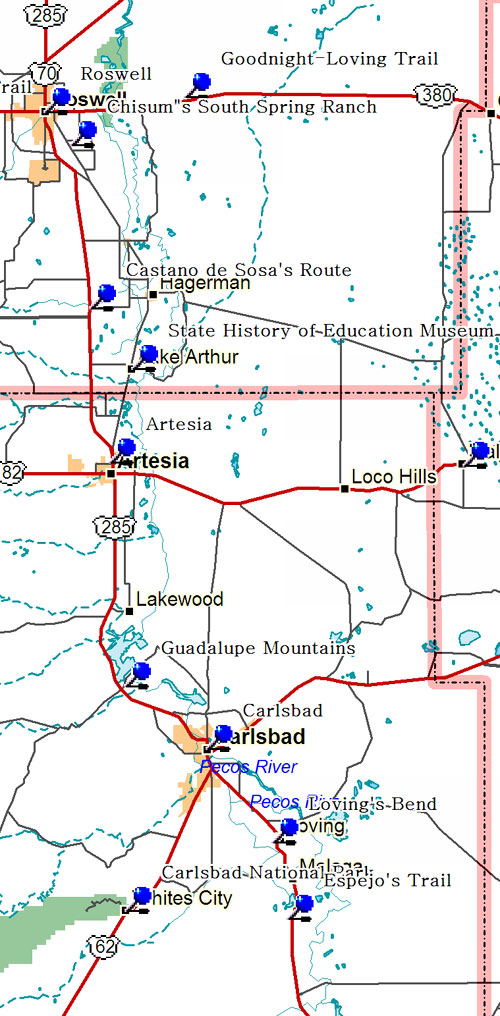
Artesia, named for area's many artesian wells, lies on the route of the Pecos Valley cattle trails used by Charles Goodnight, Oliver Loving, and John S. Chisum. The town established in 1903, is located in what was once part of Chisum's vast cattle empire.
Carlsbad was originally named Eddy after Charles B. Eddy, pioneer cattleman and promoter, but was later re-names for the famous European resort. In 1590 the expedition of Gaspar Castano de Sosa followed this part of the Pecos River, which in the 19 th century had become the center of a vast cattle empire.
These vast and magnificent caverns contain over 21 miles of explored corridors. The chambers contain countless stalactites and stalagmites unrivaled in size and beauty. The caverns are within a reef that formed in an ancient sea 240 million years ago. Millions of years later, the reef was fractured, allowing ground water to begin work fashioning the caverns.
In 1590-91, Gaspar Castano de Sosa led an expedition in an unsuccessful attempt to establish a colony in New Mexico. During the winter if 1590, as he pushed north along the Pecos River, the group passed along this route in the vicinity of present-day Artesia and Roswell.
In 1875, John S. Chisum, the "Cattle King of the Pecos," made this the headquarters of a cattle ranching empire which extended for 150 miles along the Pecos River. In that year, 80,000 cattle bore his famous Jinglebob earmark. After Chisum's death, the ranch was acquired by J.J. Hagerman.
Don Antonio de Espejo, leader of the third expedition to explore New Mexico, passed near here on his return to Mexico City in 1583. After learning of the martyrdom of two Franciscan friars from an earlier expedition, he explored the Pueblo country and then followed the Pecos River Valley south.
This famous old cattle trail, running 2000 miles from Texas to Wyoming, was blazed in 1866 by Charles Goodnight and Oliver Loving. In New Mexico, The trail followed the Pecos River north to Fort Sumner, where the government needed beef to feed the Navajos at the Bosque Redondo Reservation.
Guadalupe Mountains to southwest rise from Pecos River Valley, with higher southern peaks at 8,750 feet. Bold escarpment is famous Capitan limestone, an ancient reef similar to Great Barrier Reef of Australia, and host to Carlsbad Caverns as well as deep petroleum and underground water.
In July 1867, Oliver Loving, a partner in the Goodnight-Loving cattle concern, was seriously wounded in a fight with Comanches. While his companion, "One Armed" Bill Wilson, went for help, Loving stood off the attack for two days and nights. Loving died from his wounds at Fort Sumner in September.
Roswell was a watering place for the Pecos Valley cattle drives of the 1870s and 1880s. It was incorporated in 1891 and is seat of Chaves County, named for Col. J. Francisco Chaves, Civil War soldier and delegate to the U.S. Congress from the Territory of New Mexico. In the 1930s, Dr. Robert Goddard conducted experiments in liquid fuel rocket flights here.
Constructed in 1906, the Lake Arthur Elementary School has been memorialized as the oldest continuously used school building in New Mexico. In 1989, the New Mexico legislature designated the structure as the official New Mexico State History of Education Museum. The museum was dedicated on October 12, 1989 and features displays and artifacts from New Mexico's school districts.
|
